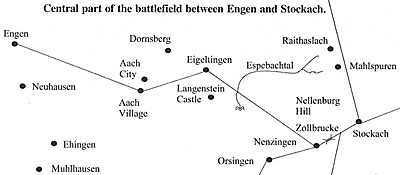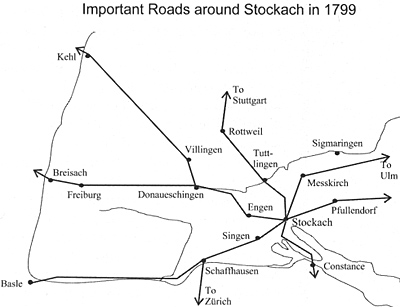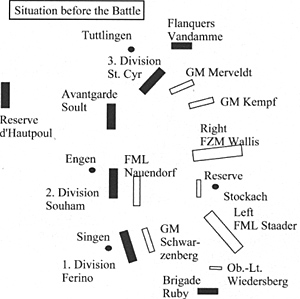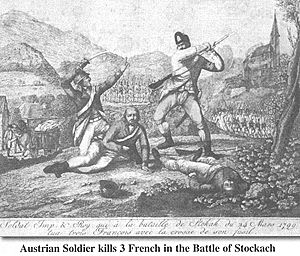Battle of Stockach
25 March 1799
Part 2
FM Petrasch’s Attack
by Roland Kessinger, Germany
| |
At this stage, Petrasch was then ordered to attack the forest in front of him. Oberst Gavasini would lead the advance: 1st Batt. IR49 would remain near the main road, while 2nd Batt. IR21 was to push forward directly from its position atop the hill. An hour after the advance began, 2nd Batt. IR21 encountered more determined French units and was pushed back. FML Petrasch therefore moved 2nd Batt. IR 49 up to support them and at the same time, 1st Batt. IR21 under GM Vogelsang was to advance from its rearward position into the line. Fierce fighting raged across the area, but Petrasch’s troops were able to slowly advance to a clearing in the forest, in which stood a single house as Vogelsang arrived. Expecting more French troops might arrive from the north and the east to outflank the Austrian right, he directed several companies to extend the Austrian line. With 1st bat. IR21 now up, FML Petrasch could hold his line and consider pushing further into the gap between Soult’s troops near the Stockach-Liptingen road and Vandamme’s men who attacked from the northeast, which was only filled with some French cavalry in the open ground between two forests. Around 4 p.m., the Austrians moved two battalion guns from IR49 forward and attacked this French cavalry, pushing them back to the second more northerly forest. The Archduke was still concerned about his right while his Grenadiers were moving up, but FML Petrasch had already reached the position required to cover them on their advance. Now near Gallmannsweil, Petrasch was informed by Staff Oberstlt Prochaska that Charles had directed the Grenadiers to advance up the main road with some cavalry and so, hje was now ordered to occupy the higher ground near Schwandorf. However, these troops would not participate in any significant fighting, as Soult’s Division was already retreating towards Neuhaus. The two battalions of IR 21 marched trough the forests as far as a hill behind Neuhaus, where they met the lead units of the Grenadiers and cavalry. The regiment halted and awaited further orders until the end of the day. However, IR49 reformed either side of the Stockach-Liptingen main road and marched in parallel with the second line of Grenadiers, before they reached a point where they could rest on the left side of the road as it exited the Graue Wald. During this advance, IR49 took some prisoners, who were sent back to the Austrian troops of the third line for further transportation. This whole episode demonstrates that the Austrians could use their units in coordinated formations and kept individual regiments together more than they had done during the War of the First Coalition, where individual battalions from the same regiment were sometimes even in different campaign areas. By the time of the pursuit, the regiments had been wholly brought together. At the tactical level, the Austrians nevertheless often still focused on the battalion as the basic unit - e.g. at the beginning of the battle one battalion of IR 49 was the reserve for one battalion of IR21 - especially at the crisis point of a battle, which is not that different from the French approach. The French perhaps focused more on concentrated more on demi-brigades, but there are many examples, including Stockach, where the French clearly only employed battalions and not whole demi-brigades for their attacks. Thus far, however, there does not appear to be an example here of the French using one battalion of a demi-brigade as the reserve for a battalion of another demi-brigade. Nevertheless, the Austrians were very successful at Stockach, basing their attacks on indidual battalions. FML Petrasch was able to push back Soult’s troops gradually, and as the Grenadiers and IR35 Wenkheim advanced on the other side of the main road, Jourdan was forced to rethink his plans. Jourdan’s counter moves
By early afternoon, Jourdan realised that he had made the same mistake as in his last great clash with Charles at Würzburg in September 1796 by underestimating the Austrian strength, but there were few options left to him now. He ordered Soult to conduct a general retreat towards the open ground in front of Liptingen, where he planned to throw in his heavy cavalry reserve. At the same time, the French commander-in-chief ordered St. Cyr to hasten his march to wards Messkirch and to send some more troops into the forests on the Austrian far right wing between Schwandorf and Muhlingen. To reinforce Soult around Liptingen, St. Cyr was to send one demi-brigade back in the direction of Neuhausen ob Eck. When Soult’s troops emerged from the Graue Wald around 4 p.m., Jourdan positioned the remaining infantry from Soult’s own Division in the forests either side of the open ground in front of Liptingen, while at the same time, deploying his reserve cavalry. GB Laval, who was commanding 67e DB at that stage, placed his troops in the forest on the northern side of the open ground, while 25e legere and 53e DB were positioned on a forest on the south side. Meanwhile, 8e DB, which was the unit St. Cyr sent back, arrived on the battlefield somewhere between Neuhausen ob Eck and Neuhaus, and would advance through a stream bed into the rear of the first Austrians troops, deploying on the northern side of the Liptingen-Stockach road near Neuhaus. Final Exchanges – Decided by CavalryAs soon as the first Austrian Grenadiers had advanced out of the Graue Wald, Jourdan decided to attack them with his heavy cavalry. However, General de Division d’Hautpoul lost about 20 minutes assembling his heavy horsemen, during which 4e and 5e Hussars tried to scatter the Grenadiers on the Homburg hill. The Austrian elite troops held their ground and in turn, scattered the Hussars. After the failure of this initial effort, the French light cavalry reformed and were ordered to join a renewed attack by the heavy cavalry. This second attack was led by the two Carabinier Regiments against the Tegethoff and Bojakowsky Grenadier Battalions near the Homburg hill. 2e Carabinier were supported by 8e Cavallerie de bataille (Heavy Cavalry) and the two Hussar regiments, while 1er Carabinier may have been supported by the 7e Cavallerie de bataille (although the sources conflict on this matter).
Unfortunately for the French, this last cavalry attack ended in complete disaster for two reasons: First, 17. Light Dragoons blocked 1er Carabinier and secondly, FML Riesch’s heavy cavalry Division had just arrived on the battlefield, as the French heavy cavalry formed for the attack. Around 5 p.m., Riesch’s Division had emerged along the main road from the Graue Wald on the right of the Tegethoff and Bojakowsky Grenadiers, under orders from the Archduke to attack the French wherever possible. At the head of the column was the Oberst-leutnant-division of 9. Nassau Kurassier under Rittmeister Quaita, who were immediately ordered by Riesch to engage the French, while the rest of the Division deployed. The French cavalry was already overextended (as FML Riesch noted in his post-battle report) so, Riesch formed the first Treffen from 5 divisions, while the second was composed of just one division. The Austrian cavalry then charged. Out in front, the Oberstleutnant-division of 9. Nassau Kurassiers assailed the French left, while the main line charged into the front. As the Austrian heavy cavalry smashed into them, the French cavalry was quickly dispersed within a few minutes, most riding off towards Liptingen, where it could only be reformed behind the infantry. A French 8pdr and approximately 200 cavalrymen with 11 officers were captured. Würzburg had repeated itself and later, Jourdan would write that the French were not capable of delivering an effective cavalry attack with several regiments, a view clearly backed up by what had happened twice to him – in 1799, two Austrian Kurassier regiments had proved superior and destroyed his cavalry between Liptingen and Neuhaus.
While Riesch dealt with the French cavalry, a few French Grenadiers were advancing out of the forest between Liptingen and Neuhausen ob Eck, threatening his right and rear. A few Züge (1/4 squadrons) were despatched, which drove the French infantry back into the forest and took 1 officer and 50 men prisoner. With his heavy cavalry wrecked, Jourdan had no further reserves to continue the battle, so he conceded defeat and withdrew. Fortunately for him, the Austrians had suffered severely too and many of the Line infantry were disoragnised after several hours of fighting in the forests. Charles focused on re-forming them and, only engaging French troops where there was little real resistance, the Austrians pushed up to Liptingen. Battle of Stockach: Part 2 25 March 1799
Destruction of 8e Demi-Brigade and the Austrian Pursuit Comments on the Battle Orders of Battle More Battle of Stockach: Part 1 25 March 1799
March 22nd and March 23rd March 24th -- First Clashes March 24th -- Evening Situation Charles' and Jourdan's Plans March 25th First Clashes First Austrian Counterattack Back to Table of Contents -- First Empire #69 Back to First Empire List of Issues Back to MagWeb Master Magazine List © Copyright 2003 by First Empire. This article appears in MagWeb (Magazine Web) on the Internet World Wide Web. Other articles from military history and related magazines are available at http://www.magweb.com |
 With IR49 Kerpen and IR21 Gemmingen, FML Petrasch had been ordered by FZM Wallis to cover the right flank of the Austrian right wing, after GM Merveldt had been forced to retreat. His attack would illustrate how the Austrians employed their infantry in the spring 1799 campaign. When he reached his designated position near Zizenhausen, FML Petrasch realised that there was a valley, which led
into the rear of the Austrian position towards Stockach. Many Austrian outposts were retreating through it and it was quite conceivable that they would soon be pursued by French troops. So he sent 1st Battalion IR 49 to the flank, leaving 2nd Battalion IR21 further east along the valley, supported from behind by 2nd Battalion IR49.
With IR49 Kerpen and IR21 Gemmingen, FML Petrasch had been ordered by FZM Wallis to cover the right flank of the Austrian right wing, after GM Merveldt had been forced to retreat. His attack would illustrate how the Austrians employed their infantry in the spring 1799 campaign. When he reached his designated position near Zizenhausen, FML Petrasch realised that there was a valley, which led
into the rear of the Austrian position towards Stockach. Many Austrian outposts were retreating through it and it was quite conceivable that they would soon be pursued by French troops. So he sent 1st Battalion IR 49 to the flank, leaving 2nd Battalion IR21 further east along the valley, supported from behind by 2nd Battalion IR49.


 Austrian Soldier kills 3 French in the Battle of Stockach
Austrian Soldier kills 3 French in the Battle of Stockach